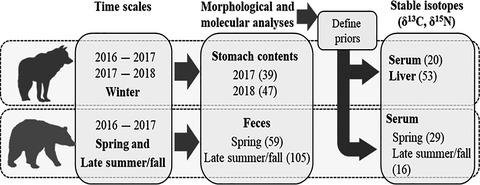当前位置:
X-MOL 学术
›
Ecol. Evol.
›
论文详情
Our official English website, www.x-mol.net, welcomes your
feedback! (Note: you will need to create a separate account there.)
Combining stable isotopes, morphological, and molecular analyses to reconstruct the diet of free-ranging consumers.
Ecology and Evolution ( IF 2.3 ) Pub Date : 2020-05-27 , DOI: 10.1002/ece3.6397 Michaël Bonin 1 , Christian Dussault 1, 2 , Joëlle Taillon 1, 2 , Nicolas Lecomte 1, 3 , Steeve D Côté 1
中文翻译:

结合稳定同位素、形态学和分子分析来重建自由放养消费者的饮食。
更新日期:2020-07-25
Ecology and Evolution ( IF 2.3 ) Pub Date : 2020-05-27 , DOI: 10.1002/ece3.6397 Michaël Bonin 1 , Christian Dussault 1, 2 , Joëlle Taillon 1, 2 , Nicolas Lecomte 1, 3 , Steeve D Côté 1
Affiliation

|
- Accurate estimates of animal diet composition are essential to untangle complex interactions in food webs. Biomarkers and molecular tools are increasingly used to estimate diet, sometimes alongside traditional dietary tracing methods. Yet only a few empirical studies have compared the outcomes and potential gains of using a combination of these methods, especially using free‐ranging animals with distinct foraging preferences.
- We used stable isotopes, morphological, and molecular analyses to investigate the diet of free‐ranging consumers with two distinct diet types, that is, carnivore and omnivore. By combining the three analytical methods to assess the diet of consumers during the same period, we aimed to identify the limits of each method and to assess the potential benefits of their combined use to derive diet estimates.
- Our results showed that the different methods led to a consistent diet description for carnivores, which have a relatively simple diet mixture, but their outcomes somewhat differed for omnivore, which have a more complex diet. Still, the combined use of morphological and molecular analyses enhanced the diversity of food sources detected compared to the use of a single method independently of diet types. Precision of diet estimates derived from stable isotope analyses was improved by the addition of priors obtained from morphological and molecular diet analyses of the same population.
- Although we used free‐ranging animals without a known diet, our empirical testing of three of the most widely used methods of diet determination highlights the limits of relying over a single approach, especially in systems with few or no a priori information about the foraging habits of consumers. The choice of an appropriate approach of diet description should be a key step when planning dietary studies of free‐ranging populations. We recommend using more than one dietary determination methods especially for species with complex diet mixtures.
中文翻译:

结合稳定同位素、形态学和分子分析来重建自由放养消费者的饮食。
准确估计动物饮食成分对于理清食物网中复杂的相互作用至关重要。生物标志物和分子工具越来越多地用于估计饮食,有时与传统的饮食追踪方法一起使用。然而,只有少数实证研究比较了使用这些方法组合的结果和潜在收益,特别是使用具有不同觅食偏好的自由放养动物。
我们使用稳定同位素、形态学和分子分析来研究具有两种不同饮食类型(即肉食动物和杂食动物)的自由放养消费者的饮食。通过结合这三种分析方法来评估同一时期消费者的饮食,我们的目的是确定每种方法的局限性,并评估它们组合使用的潜在好处,以得出饮食估计。
我们的结果表明,不同的方法对食肉动物产生了一致的饮食描述,这些动物的饮食混合物相对简单,但对于杂食动物来说,结果有些不同,因为杂食动物的饮食更为复杂。尽管如此,与使用独立于饮食类型的单一方法相比,形态学和分子分析的结合使用增强了检测到的食物来源的多样性。通过添加从同一人群的形态学和分子饮食分析中获得的先验知识,可以提高稳定同位素分析得出的饮食估计的精度。
尽管我们使用了没有已知饮食的自由放养动物,但我们对三种最广泛使用的饮食确定方法的实证测试突显了依赖单一方法的局限性,特别是在关于觅食习惯的先验信息很少或没有的系统中的消费者。在规划自由放养人群的饮食研究时,选择适当的饮食描述方法应该是关键步骤。我们建议使用不止一种饮食测定方法,特别是对于具有复杂饮食混合物的物种。











































 京公网安备 11010802027423号
京公网安备 11010802027423号